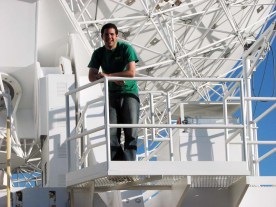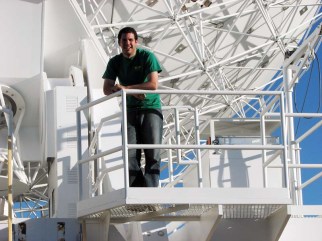From time to time, the Astro-Journalists blog will feature guest posts from the mentors of our program, here’s one by University of Chicago astrophysicist Reid Sherman:

The Combined Array for Research in Millimeter Astronomy (CARMA) is a microwave telescope made up of 23 antennas. They range in size from 3.5 meters to 10 meters in diameter, since they originated as three different observatories and were later combined by a collaboration of five universities to make a bigger, better telescope.
Because the telescope runs 24 hours a day, and takes hours to make each observation, it doesn’t make sense to have each scientist travel so far just for their own observations. But someone needs to be on site to keep an eye on things and respond to problems. So the staffing works on a time-share principle. The five universities that run the telescope have to provide various numbers of observers, who generally work two at a time in one week overlapping shifts. The University of Chicago, where I work, has to fill about 15 shifts a year, and with about 5 trained observers at the university, most of them end up going a few times a year.
Here’s a week in the life of a CARMA observer:
Monday:

The first challenge to a CARMA shift is to get to CARMA. The observatory is in the Inyo Mountains of eastern California. Because the Sierra Nevada mountains to the west are impassable for a stretch of 100 miles (and more like 200 miles in the winter, when the mountains are covered in snow), and Nevada to the east is a barren desert, the only ways to get there are from the north (Reno, Nevada), the southeast (Las Vegas), or the southwest (Los Angeles), each of which are about a four-hour drive away.
Why is it in such a remote location? For a microwave telescope, ordinary light pollution from streetlights and buildings isn’t such a big deal, but it’s still good to be away from population centers, since human activity creates all sorts of electromagnetic radiation. More importantly, though, the Sierra Nevada Mountains stop most of the moisture coming from the Pacific Ocean, so it’s very dry. Water vapor is the biggest problem for observing in microwave wavelengths, so the drier it is, the better. Being on a high plateau with mountains all around also keeps the air calm. Low wind is great for observing, because turbulence in the air disturbs the light from distant stars, blurring our observations. In fact, this is why the stars twinkle when you see them at night! Ideally for getting the best science data, we want there to be no twinkle, because that’s a sign of the light getting diverted on its way to our eyeballs. Low wind is also important because when you build a metal dish many meters across, it can catch the wind and get blown around, which you definitely don’t want when you’re trying to observe.
Since it’s so out of the way, to get there by 4PM when my shift stars means waking up very early in Chicago to catch a flight. I choose to fly to Los Angeles because there are many flights to choose from, I’m familiar with it, and I have friends who live there, so I would have people to call if something goes wrong with my trip.
After landing in LA and renting a car, it’s time for the long drive. Fortunately I have a lot of music and audiobooks to listen to, because the last couple of hours of driving feature no turns, and very few possible turns, as the only roads heading off from US-395 are dead-ends to hiking trails and campsites, or head off a hundred miles into the desert east to Death Valley.
Just north of Big Pine, there is an intersection with CA-168, where I turn and head up a windy road into the mountains. After 13 miles and a 3300 feet elevation gain, it levels off at Westgard Pass. A road heads off to the left that climbs up White Mountain to the peak of one of the tallest mountains in California, and also the location of the Ancient Bristlecone Pine Forest, the home of the oldest trees in the world (more than 4000 years old, but it’s a story for another day). On the right, so unassuming you could miss it, is a dirt road marked only by a small brown sign. It winds for a half-mile or so behind a little hill, and comes upon a set of squat buildings, and next to them, spread across a big dirt field, stand 23 large metal dishes, all staring at the sky.


Tuesday:
When things are running smoothly, an observer’s job is pretty easy. Since the scientists whose projects are approved write scripts detailing what the telescope should do and how it should be configured, doing the observations just consists of listing the scripts in a queue, writing in how long each script should run for, and pressing ‘start.’ Since each script runs for four to eight hours, and there are tools on the computers in the control room to easily see what time of day each project’s targets will rise and set, it’s not too hard to set up a queue for a whole day and just let it go.
This could seem pretty tedious and boring, but of course things don’t run that well all the time, and to keep such a large and complicated machine working requires expertise beyond part-time visitors. Most of the staff are located back down the mountain near Big Pine, at the Owens Valley Radio Observatory. They run a number of radio telescopes besides CARMA, and on most days when things are good, they can do their work from the valley, without the hefty extra commute up to CARMA. In order to diminish the isolation of being on the mountain (“at the high site”, it’s called) and to keep close communication between the observers and the staff, we generally head down to OVRO for lunch on weekdays. The observatory chef Cecil cooks lunch (and a delicious one at that) for the whole observatory staff, including the CARMA observers, and also provides us with some groceries and dinner to take up to the high site with us.

On Tuesday we head down an hour early to take part in a teleconference with the CARMA staff and CARMA scientists from the disparate universities. This keeps everybody up to date on what problems have occurred in the previous week and what the plans are for the week ahead. Having just arrived the previous afternoon, I don’t have much to add, and most of the issues that had arisen had been solved, so my prospects for a quiet, productive week of observing looked pretty good.
After lunch we have our first major alarm: two antennas have nearly collided! To free the observers from having to keep an active eye on the computer at all times, when an error occurs, it sets off a sound throughout the building. In the past the alarm has been set to play various sounds and musical tracks. This spring it’s been set to play bagpipe music, which is particularly annoying and gives a strong incentive to fix things quickly.
The way an interferometer like CARMA works is to measure the time delays of light hitting the various antennas of the array. The way the math works out is that the distance between the antennas on the ground relates to what size structures the telescope is sensitive to. To map larger objects, it’s necessary to put some dishes very close to each other, and as they move around pointing at different parts of the sky, it is possible for them to collide.
A collision can be catastrophic, because two multiton metal dishes banging together could cause dents and broken gears, so to avoid this, when antennas are close together, there are multiple buffers built in to avoid collisions. First the array is programmed to not all move at once, but to have the neighboring antennas move sequentially. Second, there is a program that runs to monitor the position of the antennas and to set off an alarm and stop all motions if they get within a few degrees of crashing. Third, each dish has wires strung all around about a foot away from the edge, and if those wires physically touch anything, it causes everything to come to a screeching halt before the dish itself hits anything.
This alarm is worrying because the first two checks failed and the wire on Antenna 8 actually physically touched another telescope. This required my partner to go out to the dish and use manual controls to move it away from its close neighbor to a safe position so we could restart observing. We later found out the reason the first two checks failed. One of the antennas had a slight error in its reporting its own position and tried to rotate the wrong direction to get to its next target. The other error was ours, as we had made the mistake of running the program to check for collisions on the wrong antennas! So we felt pretty silly, but fortunately the wires were there to save us from causing any real damage, and only caused a half-hour delay.
Wednesday:
Overnight usually one of the observers leaves the alarm speaker on in their bedroom, to respond to any problems while the other is allowed to get a full night’s sleep. Tuesday night was my night to have the alarm on, and the bagpipes woke me up twice, but fortunately for very easily fixed issues, only requiring a couple of computer commands to get the array back on track.
Wednesday is generally “maintenance day,” when staff comes up the mountain to address mechanical and computer issues and observations are generally put on hold for a bit. The big task today is that the crew is moving a few of the antennas to different locations, as the array is going into a slightly altered configuration.
To move such a massive piece of equipment takes an enormous truck. In this case the antenna is only getting moved 50 yards or so, but sometimes the array is moved into a very wide-spaced configuration with some dishes nearly a mile away on the other side of the state highway. When that happens, the highway has to be shut down for the move since the truck towing a 10-meter dish takes up the whole highway.


When the move is done, my partner and I have some actual physical work before CARMA is ready to observe again. For each antenna to be pointing in the exact correct direction, their bases must be leveled to small fractions of a degree. So we use a computer to measure the tilt of each of the moved dishes, and then go out with a big wrench and a jack and crank the legs of the dishes until their level, kind of like changing the tire on a car. It’s a bit tedious, but it makes me feel like a real scientist, messing with tools and getting away from the computer for a bit.
Thursday:
Thursday is the other shift-change day, so my observing partner of the past few days takes off to head back to his home in Berkeley that morning, and in the afternoon I get a new partner.
Two big issues came up during the day. First off, after the configuration shift, to set the calibration of the antennas’ positions, we have to observe some very bright sources for many hours to get a very strong signal. This lets each antenna figure out if it has an offset in its pointing from where it should be and can undo that offset in any calculations. It doesn’t require much work on our part, but does cause us to delay science observations for a while.
Second, while we were going through these observations, Antenna number 12 started acting awfully funny. I looked out the window and saw the dish bouncing up and down, as if it were bobbing its head to some very slow music. This is big trouble, because of course when you command an antenna to point at something, you want it to go point at it and stay there, not dance around. If it happens when we don’t notice, it will cause big delays because the other antennas will all wait for #12 to get there before taking any data. It also could put it at greater danger of colliding. It baffled and worried us, and fortunately it happened during the day when the telescope director Nikolaus was up at the site so that we didn’t panic. Some people thought it was a problem with the encoders that communicate the antennas position to the computers, and some thought it was a mechanical problem with the gears. If it was the first, it was bad because the man in charge of the encoders was on vacation, and if the latter, it was bad because it could be a terribly expensive thing to fix.
We shut Antenna 12 down and observed just with the others until we could learn more.
Friday:
By this point in the week, I have often heard the alarm enough that I start to imagine I hear it even when it doesn’t go off. Trying to fall asleep while having phantom bagpipe music in my head isn’t the easiest, but I have another stress-free night and am crossing my fingers that I don’t jinx anything.
To look at the dancing antenna, the hardware guys come up. These are classic steel-toe boots, beards, and pick-up trucks guys who deal with mechanical issues and were doing the telescope moving a couple of days ago. They find the problem with Antenna 12, which does turn out to be mechanical, but is far less cataclysmic than we feared. It turns out that a spring holding the dish against the gears lifting it was a little loose, so when raising up to high elevation (pointing almost straight up in the sky), the weight of the dish would cause it to slip and fall down until it caught again. By tightening some screws, they managed to at least temporarily fix it, and we breathe a sigh of relief.
In the late afternoon things are quiet enough that I can leave the control room for an hour or so and go running. The weather has been pleasant all week, so I try to get outside every day and get at least a little exercise while I’m there. Aside from the one state highway and White Mountain Road, there are a network of dirt roads and paths around the mountain that make for good jogging trails. Being at high altitude, the first time or two I go, I end up panting for breath pretty quickly, but by Friday I’m feeling decent enough to do a 5-mile loop around Westgard Pass without too much trouble. On the parts when I run along the highway, I usually see at least a couple of cars pass and I always wonder what they think, seeing some guy running along, 15 miles up a mountain from the nearest town, with no water or anything. The telescope isn’t visible from the road since a hill blocks the view, and it’s easy to miss the little road sign. Don’t they wonder what I’m doing in the middle of nowhere? I guess since I look unconcerned, they figure it’s no problem.

Saturday:
With observations running smoothly and nice weather, I take the day to lounge around reading a book and watching tennis and basketball on TV. That’s what I call doing science!
Weekends are often a bit more laid back at CARMA. While we still are observing 24 hours a day, because the permanent staff are off duty (unless something goes terribly wrong), we don’t have any other duties and aren’t fielding special requests.
This Saturday, though, we have a whole caravan of scientists come and take over much of the control room. This is because a week after I leave, CARMA is taking part in a very special project doing what’s called VLBI (for Very Long Baseline Interferometry). Since the farther away the dishes are in an interferometer, the smaller structures on the sky you can resolve, some scientists collaborate to go to the extreme by combining CARMA with dishes in Hawaii and Chile to essentially stretch an interferometer halfway across the earth. This is very difficult, but it’s worth it to study a few special objects, like the black hole in the center of the Milky Way, down to extremely small scales and see it in great detail.
Sunday:
My last full day at CARMA started with a minor annoyance. The alarm woke me at 3 AM, only for me to find that an observation crashed because someone deleted a necessary comma in their script. It’s an easy thing to fix and restart, especially since I’ve been at CARMA enough times to know to look for things like that (since the error messages are not always clear and helpful). But it would have been nice to sleep the whole night through.
Otherwise the week ends rather tamely. The VLBI team takes some time out of our observations for their preparations, but that also puts them in charge of taking care of the alarms, so I get to relax for the day.
The next day I am officially off duty at 9 AM, so after breakfast I’ll pack my things and drive back down to civilization. Sometimes it’s nice to live in another world for a bit, but by the end of a week it’s good to see some non-scientists and not have to worry about being responsible for a multimillion dollar piece of machinery revealing cosmic mysteries.



